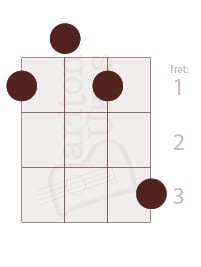
C minor
open shape
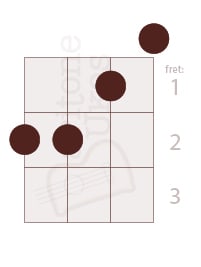
A minor
open shape
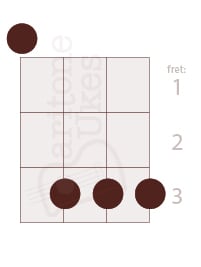
G minor
open shape
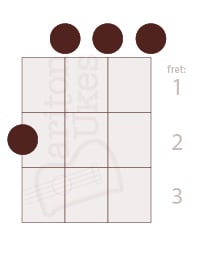
E minor
open shape
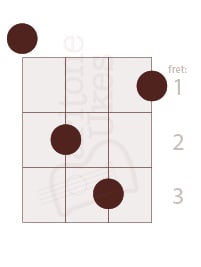
D minor
open shape
We’ll look at the moveable versions of the five shapes in a moment. Then we’ll move on to see how to use them. Next, we’ll look a fret map that shows how to use CAGED to find a C minor chord in five places. But first, let’s talk about why moveable chords are important.
Why Learn More Than One Way to Play a Chord?
Why bother with the CAGED pattern at all? Why would you need four or five ways to play the same chord? The top reason for beginners is faster, easier, smoother chord changes.
Often times, you can solve the awkward chord change problem by using a different shape on a different fret to play the chord you need.
Learning more than one way to play a chord is also the key to:
- Chord soloing: forming a melody with highest note of each chord, usually the on the E string.
- Bass lines: forming a counter-melody from the lowest note of each chord, usually on the D string.
- Riffs and runs: adding embellishments between chords.
- Variety and artistic choices.
So let’s get started:
CAGED for Baritone Uke:
The Minor Chords
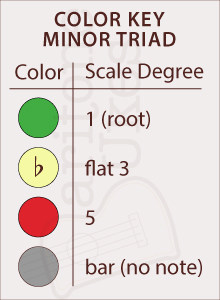
Using the color key is optional. Beginners might want to ignore the colors for now.
The colors help you learn the notes and scales that chords are built from. Learn the shapes first, then move on to learning the notes and scales.
The recipe for a major chord is 1-3-5: The first, third, and fifth note of the major scale. The recipe for a minor chord is the same, but with the third lowered one fret (one note, a half step).
1st
position
(open)
minor
chord
shapes
C
C minor
open shape
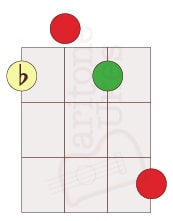
A
A minor
open shape
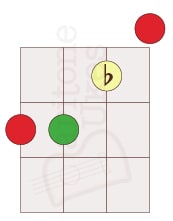
G
G minor
open shape

E
E minor
open shape
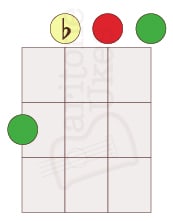
D
D minor
open shape
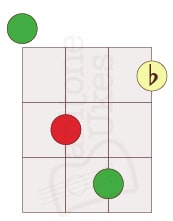
moveable
minor
chord
shapes
C
C minor
moveable
shape
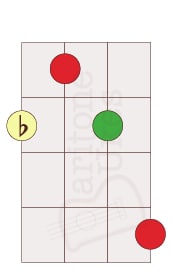
A
A minor
moveable shape

G
G minor
moveable shape
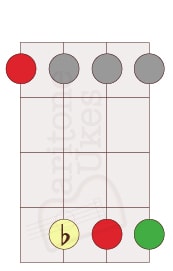
E
E minor
moveable shape
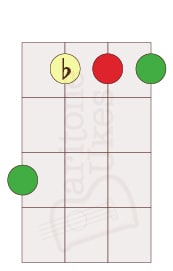
D
D minor
moveable
shape
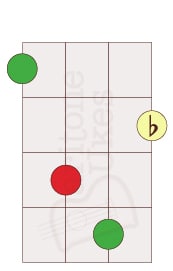
No matter which fret you play them on, though, they always form a minor chord (minor triad).

How to Use Moveable Chord Shapes on Baritone Ukulele
Remember that a minor chord shape will always give you a minor chord, regardless of where you move it. The chord quality — major, minor, major seventh, dominant seventh, and so on — doesn’t change when you use a moveable shape. The pitch changes (higher or lower), but the relationship between the notes stays the same.
Think of stars in a constellation. The stars of Orion rise in the east, move across the sky, and set in the west, but they always form the shape of the Hunter relative to each other.
There are two ways to use moveable chords on a stringed instrument:
1. Use the same shape on a different fret to play a different chord. Move the C minor shape from the open position to the 2nd fret to play a D minor chord. Move the same shape up two more frets to play an E minor, and so on.
C to D = 2 frets
D to E = 2 frets
E to F = 1 fret
F to G = 2 frets
G to A = 2 frets
A to B = 2 frets
B to C = 1 fret
If you want some help on this part, check out my article about cross-training with a cheap mini keyboard. It’s the quickest way to visualize these intervals and remember them forever.
2. Change the shape as you change frets to play the same chord in a different place. Play a C minor on the “zero” fret with the open C minor shape. Or, play a C minor on the 3rd fret with the movevable A minor shape. See the diagram below to use all five shapes to play a C minor chord. Use the word CAGED to remember the order.
To play C minor using the CAGED pattern:
C minor
A minor
D minor
E minor
D minor
C minor
C minor
C minor
C minor
C minor
Zero fret (open chord)
3rd fret
5th fret
8th fret
10th fret
CAGED for Baritone Uke:
C Minor Example
Use the 5 shapes to play C minor in five different places
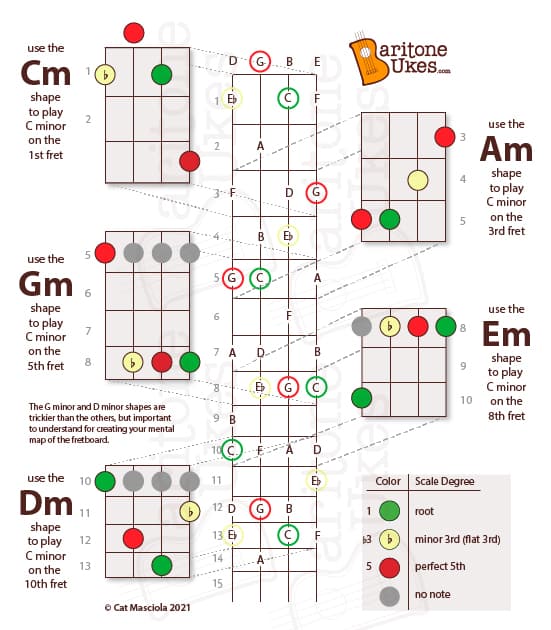
Dealing with the Difficult Shapes
Chords are a roadmap to the entire fretboard. So even if there are twists and turns you don’t intend to take—or finger-twistsing chord shapes you can’t yet make—you still want to know where the roads are how they connect to each other so you can choose how to get where you want to go.
Creating your mental map of the fretboard is going to involve understanding certain things that maybe you can’t quite play yet. That’s okay. Over time, you may surprise yourself by playing things that were out of reach for you a few months before.
Meanwhile, think of the CAGED chords as links in a chain. You can use the chain as a whole, as well as using individual links.
For example, the moveable G minor shape and the moveable D minor shape may not be very practical for beginning strummers. They aren’t what you could call beginner chords. But notice that the G minor overlaps the E minor shape before it and the A minor shape after it. Knowing where the G minor shape fits in the chain helps you find the other shapes.
Similarly, the D minor shape begins on the fret where the E minor shape ends. And the C minor shape overlaps the D minor shape. The links of the chain of interconnected.
So the CAGED chain helps you find all the individual chords, and also helps you find all the right notes when you’re soloing. So I recommend learning the five moveable shapes even if you can’t use them all yet.
How to Master CAGED for Minor Chords on Baritone Ukulele
- Learn the major chords first, then come back here and tackle the minor chords.
- Review the five open chord minor shapes and their moveable versions.
- Learn two best ways to use moveable chord shapes on baritone ukulele.
- Use the five chord shapes with the CAGED pattern for C minor.
- Use the CAGED pattern for any minor chord on baritone ukulele.
- Check out the CAGED for baritone uke FAQs.
How to Use CAGED for Any Minor Chord on Baritone Uke
The CAGED system lets you play the same chord in different places on the neck, by changing the chord shape and the fret. Work with the patterns, and soon you’ll be able to choose how you want to play a chord, to make quicker chord changes, create chord melodies, move bass lines, and make other artistic choices.
It’s pretty easy to remember the word CAGED to tell you which chord shape comes next. The tricky part of the pattern is knowing which fret is next.
As you get more experienced with baritone uke and start learning about the notes that chord are built with, it will be much easier to know which fret you want because you’ll understand the notes. But in the beginning, you’ll have to use some memorization.
These tips will help you remember:
1. As you spell out CAGED, remember you are moving up in pitch — toward the bridge.
2. After the D shape, continue the pattern by starting again with the C shape.
3. Begin with the open position of the chord you want. For example, let’s say you want to know the options for playing a G minor chord on baritone uke. Start with G minor in the open position.
4. The next shape you need will correspond with the next letter in the word CAGED. For example, to move from an open position G minor to the next option for G minor, you change from the G shape to the E shape, because E comes after G in the word CAGED.
5. The same pattern works regardless of which shape you start with. If you’re using a C shape on any fret, the next shape you can use to play the same chord will be the A shape (because A comes after C in the word CAGED).
CAGED for Baritone Uke: FAQs
Don’t see your question answered here? Let me know in the comments below.
Is CAGED the same thing as playing chord inversions on baritone ukulele?
Playing the same chords in different positions on the fretboard means you’re playing chord inversions. A chord inversion means you’re playing the same notes, but they are “stacked” differently. Because the bari uke has only about 15 or so useful frets, you run out “runway” before you repeat the same inversion again. CAGED is five inversions.
Note for theory nerds (like me!): Technically, when the root note of the chord is the lowest note played, the chord is called a root position chord rather than an inversion. The inversions are positions when the root note is not on the bottom. Hence, two of the five shapes above are technically root position chords rather than inversions. Can you spot which two?
Is CAGED the same thing as barre chords on baritone ukulele?
The CAGED pattern includes barre chords and open chords, as well as moveable shapes that sometimes aren’t formed with a barre.
What is the difference between root position and open position on baritone ukulele?
Root position means the root note of the chord is the lowest-pitch note being played, on any chordal instrument. Open position applies only to stringed instruments and simply means that at least one string is not fretted and is played “open.” Take a look at the open position chord shapes above. The green note is the root note. Which of the five open shapes are root position shapes?
What is the Difference Between CAGE and CAGED on baritone ukulele?
Many players find the moveable D shape to be rather difficult. So in practical use, players often use the other shapes and skip the difficult D.
Does CAGED work for minor chords on baritone ukulele?
Yes, CAGED does work for minor chords on baritone ukes.
What are the best fingerings for inversions on baritone ukulele? Should you bar the whole fret when playing inversions on baritone ukulele?
Fingering often depends on the chord sequence. Consider the chords that come before and after, and choose the fingering that works best for the sequence.
What is the difference between moveable shapes and barre shapes?
A moveable shape means you’re fretting all four strings at the same time. Anytime you’re fretting all four strings at once, you have a moveable shape.
A barre shape means you’re using the same finger to fret more than one string at once. If your barre shape is fretting all four strings at once, it’s moveable.


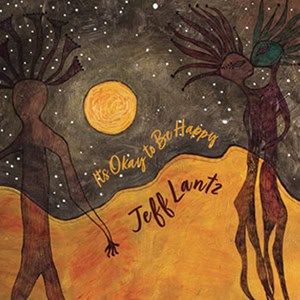
This is a great article for ‘CAGED’ beginners such as myself. Thanks!
Thank you! Glad to hear it 🙂